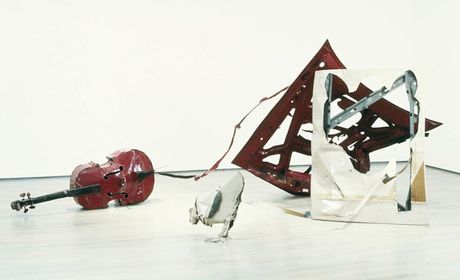
A group of eight sculptures by British artist Bill Woodrow has been removed from a sale earlier this week at the London auction house Roseberries, after their estimated conservative prices prompted intervention from players involved in the artist’s market. The works were among 40 offered in the collection of British advertising and communications company Saatchi & Saatchi.
Saatchi & Saatchi, once the world’s largest advertising agency, was co-founded by influential Iraqi-British collector Charles Saatchi and his brother Maurice. The brothers were ousted from the business in 1995, but much of his collection, including works offered at Roseberys, was acquired during Charles’ tenure, and around the same time he was buying and exhibiting rapidly works by British artists, including those associated with the Young British Artists (YBA) and the New British Sculpture movements.
At the center of the latter group is Bill Woodrow, a Royal Academician and Turner Prize nominee known for creating works from scrap materials. Woodrow had by far the most works in the Roseberys sale, which also included Lucas Samaras and Julian Opie. Almost all of the eight Woodrow sculptures that were recorded had notable exhibition histories: for example, Cello/Chicken (1983), a vast metallic installation-sculpture made from car hoods, had been presented in several international institutions including the Louisiana Museum in Denmark in 1986, and was even the cover of a text by curator Alistair Hicks on the British Contemporary Art, published in 1989.
Yet despite these factors, as well as their large sizes, the estimates for all of the Woodrow works in the sale were notably very low. Most were estimated at around £1,000-2,000, with one carrying a low estimate of £800. While Woodrow’s secondary market never reached the heights of his New British Sculpture peers such as Antony Gormley, his major works have typically sold in the five to five figures at auction.
“He’s an artist who’s represented his country at not one but five Venice Biennales. Let me get this. How the hell did someone come up with a starting price of £800?” says Jessica Smith , an adviser who previously worked at the New Art Center in Salisbury, where Woodrow had a solo exhibition in 2016. “Some of these works are not too different from his sculptures in the Tate and MoMa collections.”
This position is supported by the new British sculptor and Turner Prize winner Richard Deacon. “It would have been extremely destructive to Bill’s career if these works were tossed into a small auction house,” he says.
According to Deacon, the small sums for which Roseberys offered the work raised alarm bells among key figures associated with the Woodrow deal. The arts journal understands this led to a private agreement between the consignors and British dealers Jacob Twyford, gallery director Woodrow Waddington Custot, and Charles Booth-Clibborn to remove the works from sale. Other terms of the agreement are not known. Twyford and a Waddington Custot spokesperson declined to comment. The arts journal understands that Woodrow was aware of the sale, but does not want to comment on the situation.
A spokesperson for the auction house said: “Roseberys operates in the strictest confidence, and it is important to note that it never reveals the personal details of buyers or sellers.”
Deacon adds that a comparable situation happened to him in the 1980s when Charles Saatchi attempted to unload a number of his purchased works to exhibit alongside those of Lucian Freud and Richard Wilson. “Fortunately,” says Deacon, Nicholas Logsdail, the founder of the Lisson gallery, stepped in and offered Saatchi a deal, and eventually “moved the works” to a number of museums and institutions. “No one was hurt,” Deacon says, “and that meant Charles got a reasonable return on the money he spent.”
